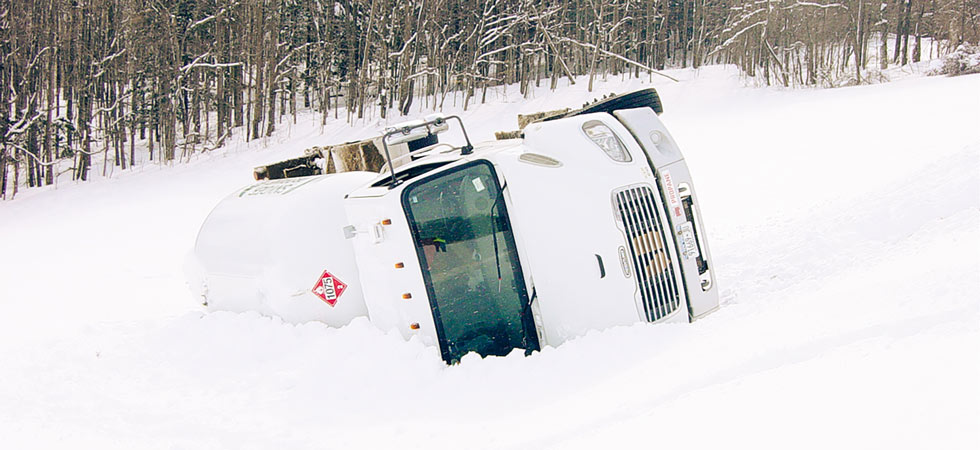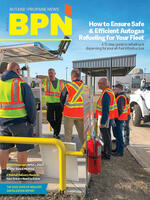
Driving propane bobtails can be a challenging endeavor. Aside from driving defensively to overcome the potential hazards you would encounter driving any other vehicle, there are unique hazards that arise from driving a propane delivery truck. In a bobtail, the weight of your load is constantly changing throughout the day as the amount of product in your tank diminishes from stop to stop, otherwise known as a “diminishing load.”
This diminishing load changes the bobtail’s center of gravity as the product volume and weight decrease. Simply put, the center of gravity is where the total weight of the vehicle is centered. The tank capacity, length and diameter — as well as the changing weight of the propane, outage and slosh — will all greatly affect the driving performance and stability of the vehicle.
A vehicle’s center of gravity plays an enormous role in its stability as it is driven between deliveries throughout the day. Propane bobtails have a variety of tank diameter sizes. A bobtail with a 72-inch diameter tank will have a lower center of gravity and be less affected by the diminishing load, changes in weight and outage than a truck with the standard 80-inch diameter tank and a higher center of gravity.
The larger the diameter of the tank, the higher the center of gravity. A truck with a 95-inch diameter tank will have a very high center of gravity and, therefore, be much more top heavy and unstable than a smaller 72-inch diameter tank. While tank diameter plays a role in determining the center of gravity, so does the amount of propane in the tank. The more propane you have in the tank, the higher the center of gravity. An 80-inch tank loaded to 85% will have a higher center of gravity than that same tank loaded to 20%.
According to code, cargo tanks of 1,200 gallons and larger can only be loaded to 85% capacity by volume to leave outage for the expansion of the propane as its temperature warms. Since there is always at least 15% of the tank that is not filled with liquid, that leaves room for the liquid to shift or “slosh” around in the tank. When a propane delivery truck is parked and the liquid is still, it has a constant center of gravity; but once the vehicle and its cargo start moving, the center of gravity is continuously shifting.
Every time the truck accelerates, brakes, turns or even hits a bump in the road, the propane is moving around the tank and shifting the center of gravity. Drivers tend to notice the effects of slosh more when the tank is not fully loaded to 85%. With more open space in the tank, the propane has more room to move around and gain momentum when moving from side to side and front to back. As your load begins to diminish, the effects of propane slosh will increase.
Propane cargo tanks are equipped with baffles that are installed between the two tank walls. A tank generally will have one or two baffles but can have more if specified by the designing engineer. The baffles help slow down the surge of propane from the rear of the tank to the front of the tank when braking and work in reverse when accelerating. They can help stop the bobtail from being pushed into an intersection when stopping on wet or icy roads. It is crucial that drivers take this into account, leaving plenty of room between themselves and the vehicle in front of them, braking slowly as well as turning slowly and smoothly.
Whether you are driving a 5,500-gallon bobtail that could weigh 53,000 pounds fully loaded (to 85% volume) or a 1,200-gallon bobtail that weighs in at 19,500 pounds loaded, it is important to know the approximate weight as your cargo diminishes. In the Northeast, 3,499-gallon bobtails are the norm. A 3,499-gallon truck will weigh in at approximately 32,200 pounds when loaded with 2,974 gallons to 85% volume.
The propane portion of that weight comes in at around 12,610 pounds. That translates into a whole lot of weight bearing down on the front head of the tank when in a steep decline or, conversely, to a large amount of weight in the rear of the tank while driving on a steep incline. Understanding the extra weight pushing you down a hill or pulling against you as you try to climb a hill is key to operating a bobtail safely.
Another thing to keep in mind when it comes to weight is overloading your bobtail. This presents its own dangers as trucks are specified to only carry a maximum predetermined weight. The problem exists because the weight calculations are performed with the standard weight of one gallon of propane weighing 4.24 pounds at 60 degrees. The size of a gallon of propane contracts as its temperature drops. So, the colder the temperature of the propane, the more gallons you can fit into that same 85%.
If a tank was loaded to 85% with 60-degree propane, the weight of the truck would be equal to the maximum weight that the truck was designed to carry. If your truck was loaded to 85% volume with zero-degree propane, the actual weight of the product would be approximately 10% more than the same 85% volume at 60 degrees.
Adding the extra 1,500 or so pounds to a 3,499-gallon bobtail can easily put it over the 33,000 gross vehicle weight rating as well as elevate it over the individual weight ratings of the axles, suspension, tires and other additional components. An overweight truck impairs your ability to operate the equipment safely as well as legally.
In short, driving a propane delivery truck can be challenging. Throughout day-to-day deliveries, the propane product is constantly diminishing and changing the vehicle’s weight and center of gravity. In addition, driving from delivery to delivery, the product in the tank is constantly sloshing and shifting the ever-changing center of gravity. Defensive driving is the most important thing a bobtail driver can do to help avoid situations that can lead to accidents caused by a higher center of gravity, product surge and weight shift.
Also, it’s important for owners and managers to provide adequate driver training. Accidents are much less likely to happen when drivers are well trained and driver safety is at the forefront of regular trainings. Discussions regarding different types of bobtail accidents, causes and how to avoid them are an integral part of helping drivers understand and avoid hazardous situations.
Different states have varying requirements for driver training, but the Federal Motor Carrier’s Association (FMCSA) now requires that all new commercial driver’s license (CDL) and hazardous material endorsement (HME) applicants complete training before they can take a CDL or HME exam. The new FMCSA requirement is called Entry Level Driver Training (ELDT).
In addition to this initial federal requirement, many states also require additional training before a driver can operate a bobtail. The Propane Education & Research Council’s (PERC) Certified Employee Training Program (CETP) 2.2 Bobtail Delivery Operations course has become a requirement in some states and touches on defensive driving and other aspects of delivering propane safely.
Driver training needs to be a continuous focus of owners and managers. Resources can be found through the National Propane Gas Association (NPGA) and their Administrative Compliance Experts (ACE) service. They offer entry level driver training that meets the FMCSA requirement.
PERC offers CETP 2.2 Bobtail Delivery Operations, as well as a publication called Preventing Bobtail Rollovers, which is very insiteful for drivers. FMCSA also has great training materials on cargo tank rollover prevention.
A countless number of additional materials can also be found with a simple search on the internet to aid you in keeping your delivery drivers focused on one of the most important aspects of their job — safety.


